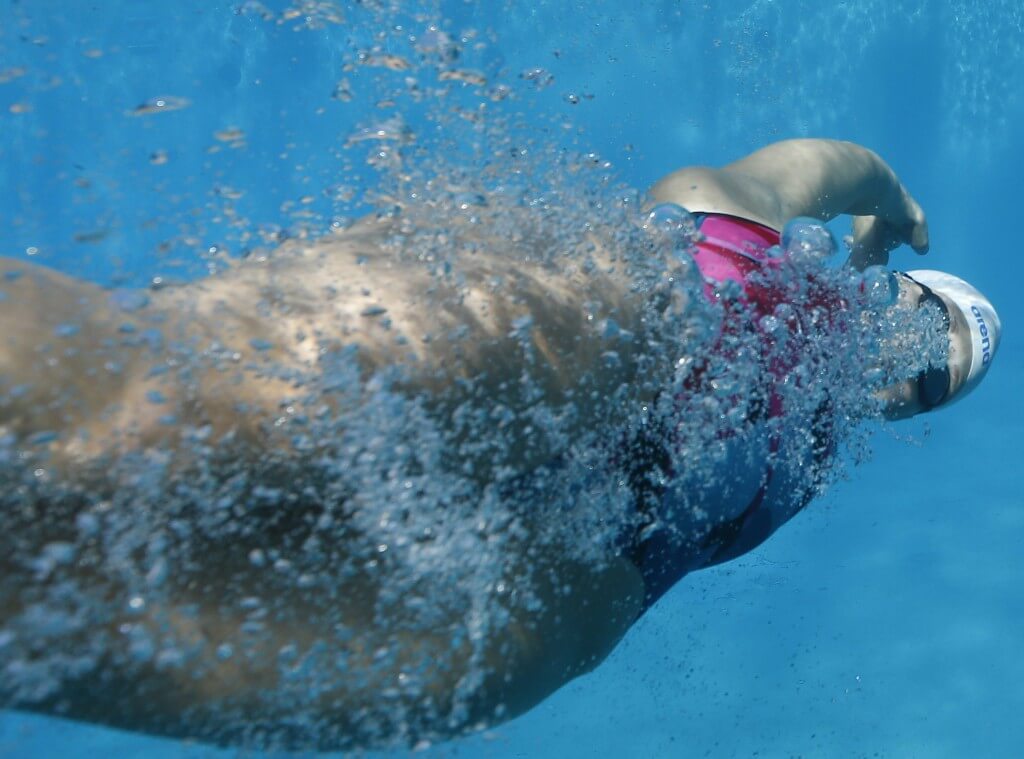Resisted and Assisted Pool Training Covered in This Week’s Workout

Photo Courtesy: Bob Stanton-USA TODAY Sports
By Ronald Hehn
MOORHEAD, Minnesota, September 18. PHYSICAL therapy methods often utilize tools to assist a patient performing a disabled movement. Throughout the healing process, a patient gradually reduces assistance until the desired movement is performed without assistance. For swimmers, equipment such as resistance bands, fins, and paddles may be used to assist an athlete to achieve a desired performance. This workout utilizes resistance and assistance to improve an athlete’s propulsion and technique.
Resisted swims may increase propulsion by requiring an athlete to overcome resistance caused by the band (N.B. in the absence of bands, parachutes or other drag devices may be substituted). On land, resistance training is a common method used to increase strength; in the water, increased strength contributes to increased propulsion. Added resistance may impair technique if the athlete compromises technical efficiency for increased propulsion; however, in this workout the maladaptation is short-lived.
Assisted swims increase efficiency as the band provides propulsion while the athlete can identify technical inefficiencies. The athlete must be aware of technical adjustments that increase velocity; assistance from the band provides more velocity than the swimmer can generate on their own, allowing the athlete to focus entirely on technique rather than propulsion. Appropriate associations occur when technical adjustments are made at race pace.
The broken 50 (4×12.5), 100 (4×25), and 150 (4×37.5) utilize adapted technique and propulsion in order to swim at race pace. The athlete must combine efficient technical adjustments from the assisted swim and increased propulsive techniques from the resisted swim in order to achieve maximum velocity. In addition, increased propulsion provided by fins and paddles will result in greater overall velocity.
4×12.5 provide the opportunity for the athlete to be explosive while glucose is abundant and blood-lactate levels are low. The 4×25 must match the time on the assisted 25; the time should be at race pace for a goal 100. The 4×37.5 must match the time on the resisted 25; the time must be within 5 seconds of their goal 50. 37.5 repetitions allow the athlete to practice turns at different levels of fatigue and velocity; the first and third repetitions require that the turn is performed after an entire 25, while the turn is performed after a 12.5 on the second and fourth repetitions
The outcomes of the 50’s on the “Perform” component should be within 1 second of each other, despite fatigue; the pace should represent the final 2×50’s of a goal 200 performance. The athlete must combine the peak velocity of the 12.5 repetitions with the turn and break-out practiced during the 37.5 repetitions in order to construct the best possible 50.
This workout generates high blood-lactate levels due to anaerobic activity combined with long periods of rest (i.e. > 20 seconds); lactate may be utilized as fuel during the hypoxic (i.e. without oxygen) warm-down in order to lower the concentration of lactate in the body. Hypoxic exercise utilizes lactate much quicker than aerobic exercise (cf. Pasteur Effect); consequently, the hypoxic nature of the warm-down is more efficient at eliminating excess lactate than an aerobic warm-down.
Hypoxic training without proper supervision is dangerous. Please make sure any hypoxic training is done with a properly-trained person around to supervise the practice.
For more on the dangers of hypoxic training, please see this interview on Shallow Water Blackout.



